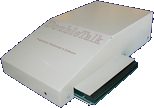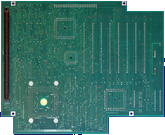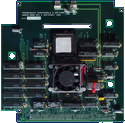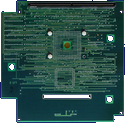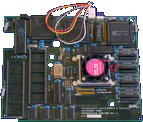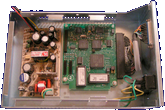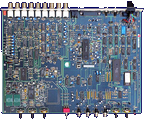Search Result
19 expansions found
Company Progressive Peripherals & Software, USA | Date 1991 | Amiga A2000, A3000, A4000 | Interface Zorro II | Autoconfig ID 756 / 2 |
- AppleTalk interface
- existing AppleTalk networks:
- unlimited number of Macs may be networked
- 230,4 kbit/s transfer speed (AppleTalk standard)
- cannot access Macs with MacOS 7.x or later
- can share files and printers
- Amiga only networks:
- up to 32 Amigas may be networked
- 460,8 kbit/s transfer speed (between other DoubleTalk or Emplant cards)
- allows any Amiga to function simultaneously as a file server, printer server or client
- can share large RAM disks
- supports network distributive software to take advantage of the processing power of several networked Amigas
- 512 kB ROM
- phone jack network adapter
- additional DB25 serial port for the Amiga - due to a misdesign this serial port is not available as long as the AppleTalk connector is connected (it uses the same hardware interrupt)
- software utilities: Network Manager, AutoLogoff, AutoPublish, password security, NetMail
Company Progressive Peripherals & Software, USA | Date 1991 | Amiga A500 | Interface side expansion port | Autoconfig ID 756 / 2 |
- AppleTalk interface
- existing AppleTalk networks:
- unlimited number of Macs may be networked
- 230,4 kbit/s transfer speed (AppleTalk standard)
- cannot access Macs with MacOS 7.x or later
- can share files and printers
- Amiga only networks:
- up to 32 Amigas may be networked
- 460,8 kbit/s transfer speed (between other DoubleTalk or Emplant cards)
- allows any Amiga to function simultaneously as a file server, printer server or client
- can share large RAM disks
- supports network distributive software to take advantage of the processing power of several networked Amigas
- 512 kB ROM
- phone jack network adapter
- additional DB25 serial port for the Amiga - due to a misdesign this serial port is not available as long as the AppleTalk connector is connected (it uses the same hardware interrupt)
- connects to the side expansion port
- software utilities: Network Manager, AutoLogoff, AutoPublish, password security, NetMail
Company Progressive Peripherals & Software, USA | Date 1988 | Amiga A500 | Interface 68000 socket |
- 1 MB Fast RAM expansion
- 32 DIP sockets for 256×1, 100 ns chips
- plugs into the 68000 socket - the 68000 is replaced onto the board
- big board, covers a large area inside the A500
Company Progressive Peripherals & Software, USA | Date 1988 | Amiga A500 | Interface 68000 socket | Autoconfig ID 756 / 2 |
- 64 DIP sockets accept 2, 4 or 8 MB RAM
- accepts 1M×1 DIPs
- socket for optional 68881 @ 12 / 16 / 25 MHz
- plugs into the 68000 socket - the 68000 is replaced onto the board
Company Progressive Peripherals & Software, USA | Date 1988 | Amiga any Amiga | Interface parallel port |
- framegrabber
- realtime digitizing in 1/60th of a second - but transferring the image to the Amiga takes several seconds
- separate PAL and NTSC versions
- supported NTSC resolutions are 320×200, 384×240 (overscan), 320×400, 640×200, 640×400
- can digitize in colour (except in 640×400) in 2, 4, 8, 16, 32, 64 (EHB) or 4096 (HAM) colours, in 16 grays or in definable pseudo colours
- uses its own built-in RAM to digitize
- external control knobs for intensity (brightness), hue (colour bias) and saturation
- composite input (RCA connector)
- connects to the parallel port (Centronics) and between the monitor and the RGB port (2× DB9)
- external power supply
- FrameGrabber 2.0 software
- pre-digitizing options:
- Over Sampling - digitize an image any specified number of times up to 50 and combine them into a composite (gives far better results than a single capture)
- Multiple Exposure - gives two samples
- Mirror Image
- Weighted - modifies the automatic contrasting performed
- Auto Zone - improves image quality in the center at the expense of the border areas
- these options can be combined in a variety of ways
- post-digitizing options include: edge detection, sharpening, averaging, photographic negative
- slow-scan mode - digitize a still object through the supplied colour wheel with a black and white camera
- supported file formats:
- IFF, IFF24, RAW
- DV21 (DigiView Gold's 21 bit format)
- Brush (for areas smaller than the screen)
- Palette (for saving only colour information)
- LUT (contains information for the pseudo colour option)
- ANIM
Company Progressive Peripherals & Software, USA | Date 1990 | Amiga any Amiga | Interface parallel port |
- framegrabber
- grabs images in 256 gray levels (the original colour capable FrameGrabber can achieve 16 gray levels only) - suitable for capturing 24 bit images in three pass
- 24 bit colour images can be obtained with three pass digitizing using the supplied colour wheel
- cannot digitize in realtime - digitization takes 1/30th of a second and transferring the image to the Amiga plus displaying it takes 5 to 25 seconds
- uses its own built-in RAM to digitize and display 256 gray levels on the Amiga screen (framebuffer)
- supported resolutions are 320×200, 320×400, 384×240 (overscan), 384×480 (overscan)
- external control knobs for intensity and black level
- four composite inputs (RCA connectors) working in two ways:
- all inputs accept independent video signals, each of which can be either monochrome or colour composite (treated as monochrome) - the active input is selected via software
- the first three inputs accept colour video as separate red green and blue signals, and the fourth accepts the composite synchronization signal - in tandem with a colour RGB video camera, a colour image can be taken without colour wheel, in three pass
- connects to the parallel port (Centronics) and between the monitor and the RGB port (2× DB9)
- external power supply
Company Progressive Peripherals & Software, USA | Date 1987 | Amiga A1000 | Interface side expansion port |
- No description available.
Company Progressive Peripherals & Software, USA | Date 1991 | Amiga A3000 | Interface CPU slot | Autoconfig ID 2026 / 0 |
- processor
- 68040 @ 28 / 35 MHz
- both version is an overclocked 25 / 33 MHz one
- memory
- eight 30 pin SIMM sockets accept 32 MB
- supports 1 or 4 MB SIMMs 40-80ns (33 MHz model) or 60-100 ns (28 MHz model)
- accepts SIMMs in groups of four giving 4, 8, 16, 20, 32 MB RAM
- Fast Page, Static Column and Nibble mode SIMMs are supported
- burst RAM access
- off-board memory burst access if most recent Buster, DMAC and Ramsey chips are installed
- notes
- if the motherboard is fitted with static column fast RAM the first chip must be replaced with the supplied page mode ZIP DRAM chip - this solves a bug in Ramsey and allows the board to do burst RAM access
- 68030 fallback mode works only with 25 MHz motherboards
- in 68030 fallback mode the onboard RAM is still useable but it's not contiguous with the motherboard RAM
- when used in an A3000T, a 74F08 chip must be inserted at location U103 on the motherboard
- FastROM jumper reserves 1 megabyte of memory for FastROM usage
- two floppy power connectors allow distribution of power to both floppy drives
- Mercury040.pdf
user manual
1064 kB - Mercury040_Addendum1.pdf
addendum to the user manual
40 kB - Mercury040_Addendum2.pdf
addendum to the user manual
684 kB
- PPS_040.dms
Install Disk
Init040 v2.2, CPU040 v2.4, 68040.libary v37.4
281 kB - PPS_Mercury.dms
Install Disk
Init040 v1.0, CPU040 v2.0, 68040.libary v40.2
73 kB - PP&SMercury.DMS
Installer's Heaven
install disk
73 kB
Company Progressive Peripherals & Software, USA | Date 1989 | Amiga any Amiga | Interface RGB port |
- genlock
- composite input and output (2× RCA)
- connects directly to the RGB port
- no RGB passthrough connector
- mixed mode - graphics overlayed on video
- picture mode - shows external video alone
- graphics mode - displays graphics only
Company Progressive Peripherals & Software, USA | Date 1988 | Amiga any Amiga | Interface RGB port, parallel port |
- genlock
- composite input and output (2× BNC)
- controlled by software through the parallel port
- Background mode - colour zero is transparent, all others float above the live video backdrop
- Foreground I mode - permits colours other than colour 0 to become transparent
- Foreground II mode - restores opaqueness to the colours used in Foreground I mode
- Video mode - shows external video alone
- Amiga mode - displays graphics only
Company Progressive Peripherals & Software, USA | Date 1991 | Amiga A2000 | Interface CPU slot | Autoconfig ID 756 / 1052026 / 105 |
- processor
- 68040 @ 28 MHz (clocked asynchronously to the A2000 motherboard)
- memory
- eight 30 pin SIMM sockets accept up to 32 MB RAM
- takes 1 or 4 MB SIMMs, 80 ns or faster
- accepts SIMMs in groups of four giving 4, 8, 16 or 32 MB configurations
- not autoconfiguring - requires software
- does not give contiguous 32 bit RAM, it separates 2 MB as 16 bit RAM - RomTagMem is required to make it all 32 bit and contiguous
- up to 8 MB RAM can be configured in the 68000 address space (2, 4 or 8 MB) - access is slower to this RAM
- burst RAM access
- jumper settings
| B1 - | SIMM type: ON - page mode, OFF - Nibble mode |
| B2 - | SIMM size: ON - 1 MB, OFF - 4 MB |
| B4 - | motherboard: ON - german, OFF - B2000 |
| A1 OFF OFF ON ON |
A2 ON ON OFF OFF |
B3 ON OFF ON OFF |
auto-config memory - 0 MB - 2 MB - 4 MB - 8 MB |
| A3 ON OFF |
A4 OFF ON |
- CPU - 68000 - 68040 |
| C1 ON OFF |
C2 OFF ON |
- cache - enabled - disabled |
| C3 ON OFF |
C4 OFF ON |
- burst mode - enabled - disabled |
- Progressive040_2000.pdf
user manual
377 kB
- PPS_040.dms
Install Disk
Init040 v2.2, CPU040 v2.4, 68040.libary v37.4
281 kB - PPS040.DMS
Installer's Heaven
install disk
280 kB
Company Progressive Peripherals & Software, USA | Date 1991 | Amiga A3000 | Interface CPU slot | Autoconfig ID 2026 / 1 |
- processor
- 68040 @ 25, synchronous with the motherboard
- drives 16 MHz motherboards at 25 Mhz
- notes
- no memory option - slow motherboard RAM access
- requires ROM resident Kickstart 2.0
- 68030 fallback mode, switchable from software
- if the motherboard is fitted with static column fast RAM the first chip must be replaced with the supplied page mode ZIP DRAM chip - this solves a bug in Ramsey and prevents the board of doing burst RAM access
- Progressive3000.pdf
User Manual
15.0 MB - Progressive3000_Addendum1.pdf
User Manual Addendum: Static Column Mode, 16 MHz A3000 Jumper Settings
3.0 MB - Progressive3000_Addendum2.pdf
User Manual Addendum: A3000T Jumper Settings
1605 kB
Company Progressive Peripherals & Software, USA | Date 1992 | Amiga A500 | Interface 68000 socket | Autoconfig ID 2026 / 187 |
- processor
- 68040 @ 28 / 35 MHz
- both version is an overclocked 25 / 33 MHz one
- memory
- sixteen ZIP sockets accept 4 or 8 MB RAM
- supports 1M×4 ZIPs
- autoconfigures all A500 internal / external RAM
- notes
- connects to the 68000 socket - the 68000 is replaced onto the board
- RF shield must be removed - the 040 is too big to fit under it
- Kickstart 2.04 ROM built in - the 040 does not work under 1.3
- 68000 fallback mode switchable by software
Company Progressive Peripherals & Software, USA | Date 1989 | Amiga A2000, A3000, A4000 | Interface Zorro II | Autoconfig ID 1023 / 2 |
- 64 DIP sockets accept 8 MB RAM
- accepts DIPs in groups of 16 giving 2, 4, 6 or 8 MB RAM
- supports 1M×1 (411000) DIPs only
- no waitstates
- memory autoconfig
- the design is licensed from ASDG, the card is technically the same as the ASDG 8MI
Company Progressive Peripherals & Software, USA | Date 1991 | Amiga A3000, A4000 | Interface Zorro III | Autoconfig ID 2026 / 120 |
- sixteen 30 pin SIMM sockets accept 64 MB RAM
- supports 1 or 4 MB SIMMs 60-80 ns
- accepts SIMMs in groups of four
Company Progressive Peripherals & Software, USA | Date 1991 | Amiga A2000, A3000, A4000 | Interface Zorro II | Autoconfig ID 2026 / 68 |
- realtime digitizer and video processor
- twin board
- video and graphics, DTP, CAD system
- TMS34020 processor
- 40 MFLOPS peak speed at 40 MHz
- 32 bit architecture with 512 byte cache
- TMS34082 coprocessor
- 32 bit math / graphics coprocessor
- 3D vector support and rendering engine
- parallel processing capability
- memory
- 8 MB of 44C251 1 Mb VRAM (two 4 MB banks)
- pixel / bit aligned block transfer rate of 142 Mbits/s
- 8 MB of DRAM for resident applications
- input: RS-170A (composite), CCIR-624 (PAL), and RGB (DB9 Targa Pin Compatible)
- output: RS-170A (composite), CCIR-624 (PAL), externally synchable (genlockable) RGB (DB9 Targa Pin Compatible)
- RGB resolutions
- variable from 320×400 to 1024×1024, in 8 or 32 bits
- 1024×2048 scrollable work area by combining the two buffers
- non-interlaced: 320×400, 320×480, 640×400, 640×480, 512×512, 640×640, 800×600, 800×640, 1024×512
- interlaced: 800×800, 1024×768, 1024×1024
- thousands of other custom resolutions possible
- composite resolution: 768×480 (NTSC), 768×576 (PAL)
- pixel depth: 8 bit or 32 bit, user definable
- horizontal scan rate
- programmable 15.734 kHz (nominal NTSC), 15.625 kHz (nominal PAL)
- range 15-34 kHz
- vertical scan rate
- programmable 30 Hz (nominal NTSC), 25 HZ (nominal PAL)
- range 25-100 Hz
- interlace: programmable 2:1 interlaced, or non-interlaced
- Amiga bus interface: 4×128 kB DMA blocks, directly addressable
- hue, saturation, contrast: software adjustable via digital pots in 256 levels each
- palette
- 16.7 million colours displayable from a palette of 16.7 million
- alternative display of 256 colours from a palette of 16.7 million
- overlay
- 8 bit alpha channel with 16 colour overlay
- alpha channel colour key between buffers
- image capture
- full frame and field capture in 1/30th or 1/60th of a second
- realtime image capture in 24 bits up to 1024×1024 resolution
- grayscale image capture in 256 shades
- multiple resolutions in composite and RGB, up to 1024×1024
- two framebuffers with adjustable resolutions of up to 1024×1024 pixels per buffer in 32 bit colour
- image processing
- bit blitting
- hardware zoom and pan
- dynamic resizing
- runlength encoding
- JPEG compression support
- image enhancement, image recognition, histography, and many other functions built in hardware
- digital video effects: flipping, page turns, colourization, solarization, polarization, up to 8:1 zoom, rotations, picture in picture , live resizing, digital graphic overlay and many realtime 24 bit animation and digital video effects
- SAGE Library: over 200 graphic functions, with 2D and 3D graphic libraries: LINEDRAW, POLYDRAW, CUBICSPLINE, PHONGSHADE, GOURADSHADE, and more.
- fast image loading: NTSC overscan image in less than a second, 1.5 MB 24 bit image in less than 4 seconds
- multiple Rambrandt boards can be linked together to create exceptional virtual reality systems
Company Progressive Peripherals & Software, USA | Date 1990 | Amiga A500, A1000 | Interface side expansion port |
- OMTI controller
- "The Vault" is a name variation of the Megatronic OMTI Adapter
- delivered with a partitioning software (Utility Manager) and Progressive's file management utility, CLImate
Company Progressive Peripherals & Software, USA | Date 1991 | Amiga any Amiga | Interface RGB port |
- genlock, switcher
- a professional video switching system featuring luma-keying, genlocking, local 24 bit colour generation, video fading/wiping and stereo audio mixer
- four channels: composite video in with passthrough, externally synchronized RGB in, Amiga RGB in, and the internal colour generator for background color
- hue, saturation and contrast control is provided on the front panel
- connects to any Amiga (including the A1000) through the RGB port
- controlled through the serial port
- RGB out port (DB23, for Amiga graphics)
- stereo audio out (2× RCA)
- two stereo audio input channels (4× RCA)
- composite video: 1× in, 2× out, 1× passthrough (BNC)
- RGB in (3× BNC)
- does not require time-base corrected inputs
- available in PAL and NTSC
- features
- genlocking:
- overlay Amiga graphics onto any video source or onto a solid one-colour screen
- four genlock modes: foreground, inverted, mixed and encoded
- notch filter and fade capability gives a wide range of genlocking options and effects
- the Video Blender software does not need to be active during the genlocking process
- fading:
- fade between any two sources
- smooth fading from 0 to 10 seconds in increments as small as 40 ms
- supported in all genlock modes, including luma-keying
- fully programmable and sequenceable with other events
- mixing:
- mix any two video sources for ghost, double exposure or tinting effects
- mix delay can be set from 0 to 10 seconds in increments as small as 40 ms
- switching:
- switch between any two of Video Blenders four channels
- switching is instantaneous and flicker-free, and is fully programmable and sequenceable with other events
- keying:
- key between any two of Video Blenders four channels for effects such as weather map, split screen video, any size or shape picture-in-picture, invisible man
- all effects have sharp, crisp edges with notch filter option
- key on 256 shades of gray from black to white
- fully programmable and sequenceable with other events
- wiping:
- pixel level control of wiping between any two sources
- every aspect of each wipe is adjustable: size, direction, speed, repetition, delay, rows, columns and more
- with Video Scriptor (wipe sequencer and control tool) any IFF animation can be used as a wipe in addition to the algorithmic wipes
- MixMaster custom wipe-paint software for easy creation of spectacular IFF wipes
- fully programmable and sequenceable with other events
- stereo audio:
- Video Blender's two stereo input channels can be switched, mixed or faded
- fade times are adjustable from 0 to 10 seconds in increments as small as 40 ms
- the mixed audio output may be synchronized to video events
- attenuation control knobs on the front panel allow the matching of stereo input levels
- programming and sequencing:
- every setting and feature may be saved as a Video Blender event
- events may consist of a series of wipes, fades, mixes, etc.
- in addition titling sequences, external tasks and other software may be part of an event
- multiple events may be sequenced and saved in video sessions
- 24 bit colour generator for background screens and colour transitions
- black burst out, synched with composite video in
- key in for chroma-keying and other effects
- GPI trigger allows the sequencing of Video Blender with other studio equipment
- loop through for previewing composite video output without sacrificing a video channel
Company Progressive Peripherals & Software, USA | Date 1992 | Amiga A2000 | Interface CPU slot | Autoconfig ID 756 / 1502026 / 150 |
- processor
- 68040 @ 28 / 33 MHz
- memory
- sixteen 30 pin SIMM sockets accept 64 MB RAM
- supports 1 or 4 MB SIMMs 60-80 ns
- accepts SIMMs in groups of four
- not all of the memory is autoconfigured - requires software
- SCSI 2 controller
- 53C710 controller IC
- 50 pin internal header
- DB25 external connector
- mounting bracket for attaching a 3.5" hard drive to the back of the card
- badly written SCSI driver steals all the CPU time when accessing the devices
- supported by NetBSD and OpenBSD
- notes
- at least one group of four SIMMs must be installed in order to use the card
- in 68000 fallback mode the autoconfig memory is still useable, it just becomes 16 bit
- it's not advised to set more than 2 MB to be autoconfigured
- Jumper Settings
| Jumper | Description | Setting |
| A1,A2 | Memory Configuration | CLOSED-CLOSED - 0 MB OPEN-CLOSED - 2 MB CLOSED-OPEN - 4 MB OPEN-OPEN - 8 MB |
| A3 | Autoboot | CLOSED - Enable OPEN - Disable |
| B1,B2,B3 | Memory Bank Configuration | CLOSED-CLOSED-CLOSED - 0 Banks OPEN-CLOSED-CLOSED - 1 Bank CLOSED-OPEN-CLOSED - 2 Banks OPEN-OPEN-CLOSED - 3 Banks CLOSED-CLOSED-OPEN - 4 Banks |
| B4 | Machine Type | CLOSED - A2000 OPEN - B2000 |
| C2 | Boot Priority | CLOSED - 68040 OPEN - 68000 |
| C3 | Cache Control | CLOSED - Enable OPEN - Disable |
| C4 | Burst Control | CLOSED - Enable OPEN - Disable |
| D1,D2 | Memory Speed (28 MHz Model) | CLOSED-CLOSED - 60ns RAM OPEN-CLOSED - 80ns RAM CLOSED-OPEN - 100ns RAM OPEN-OPEN - undefined |
| D1,D2 | Memory Speed (33 MHz Model) | CLOSED-CLOSED - undefined CLOSED-OPEN - 60ns RAM OPEN-CLOSED - 80ns RAM OPEN-OPEN - undefined |
 Amiga Hardware Database
Amiga Hardware Database


